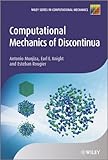Computational mechanics of discontinua / Antonio A Munjiza, Earl E. Knight, Esteban Rougier.
Material type: TextSeries: Wiley series in computational mechanicsPublication details: Chichester : Wiley, 2012.Description: 1 online resource (xiv, 267 pages) : illustrationsContent type:
TextSeries: Wiley series in computational mechanicsPublication details: Chichester : Wiley, 2012.Description: 1 online resource (xiv, 267 pages) : illustrationsContent type: - text
- computer
- online resource
- 9781119971184
- 1119971187
- 9781119973010
- 1119973015
- 9781119973027
- 1119973023
- 9781119971160
- 1119971160
- 531 23
- QA808.2 .M87 2012eb
- TEC006000
Includes bibliographical references and index.
Front Matter -- Introduction to Mechanics of Discontinua -- Methods of Mechanics of Discontinua -- Disc to Edge Contact Interaction in 2D -- Triangle to Edge Contact Interaction in 2D -- Ball to Surface Contact Interaction in 3D -- Tetrahedron to Points Contact Interaction in 3D -- Tetrahedron to Triangle Contact Interaction in 3D -- Rock Joints -- MR Contact Detection Algorithm for Bodies of Similar Size -- MR Contact Detection Algorithm for Bodies of Different Sizes -- MR Contact Detection Algorithm for Complex Shapes in 2D -- MR Contact Detection Algorithm for Complex Shapes in 3D -- Parallelization.
"Mechanics of Discontinua is the first book to comprehensively tackle both the theory of this rapidly developing topic and the applications that span a broad field of scientific and engineering disciplines, from traditional engineering to physics of particulates, nano-technology and micro-flows. Authored by a leading researcher who has been at the cutting edge of discontinua simulation developments over the last 15 years, the book is organized into four parts: introductory knowledge, solvers, methods and applications. In the first chapter a short revision of Continuum Mechanics together with tensorial calculus is introduced. Also, a short introduction to the finite element method is given. The second part of the book introduces key aspects of the subject. These include a diverse field of applications, together with fundamental theoretical and algorithmic aspects common to all methods of Mechanics of Discontinua. The third part of the book proceeds with the most important computational and simulation methods including Discrete Element Methods, the Combined Finite-Discrete Element Method, Molecular Dynamics Methods, Fracture and Fragmentation solvers and Fluid Coupling. After these the reader is introduced to applications stretching from traditional engineering and industry (such as mining, oil industry, powders) to nanotechnology, medical and science"-- Provided by publisher.
Print version record.
Physical Science
